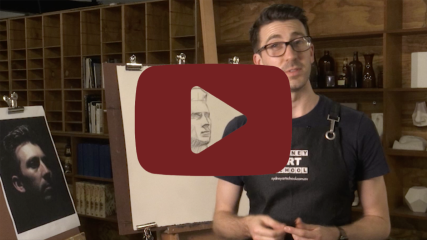Lesson 1 (Preview)
Introduction to Portraits
How to start a portrait drawing from a photographic reference
Materials used in this lesson
Willow charcoal, compressed charcoal stick, kneadable eraser, dry brush.
Lesson Tips
1. Keep your early marks light and loose. This allows you to make revisions as your drawing develops.
2. Forget what you think you know, and take care to observe the actual proportions of the subject before you begin drawing.
3. Hold your drawing implement loosely, and start with light marks.
4. Look deeply into your subject to define edges which may be lost in darker shadows or bright highlight areas.
5. Use short straight lines to map out the proportion of your subject. These early marks will be covered or erased as the drawing develops.
6. Step back constantly to review your work from a distance. It is far easier to check proportions and make accurate adjustments in the early stages of your drawing.
7. Avoid detail at the start, and focus on capturing the big shapes made by the shadows and light facing areas.
8. Suggest detail with simple strokes in the early stages, as accurate proportions should be your priority.
9. Focussing on the basics will ensure the details look after themselves.
10. Begin adding tone by using the side of your charcoal to lightly shade the dark areas.
11. Think about shadows and highlights and how the general direction of the light will reveal form in your portrait.
12. Always think about proportion and resist the temptation of adding detail for as long as possible.
13. Use the dry brush to soften your shadows and spread the charcoal in areas where tone is needed.
14. Kneadable erasers can be squeezed into specific shapes to lift highlights in any form required.
15. Think about your eraser as a drawing tool that makes reverse marks out of dark tone.
16. Introducing dark tones will increase contrast and increase the dynamic look of your drawing.
17. Be patient and take your time. Realistic drawings require lots of practice and effort. Constant observation will reveal more to refine.
18. The dense tone of compressed charcoal will give you rich blacks to dramatically increase contrast and detail in your drawing.
19. Use the dry brush to soften the transition between light to dark, and round the form to create a three dimensional surface effect .
20. Squinting is a useful technique that eliminates distracting detail and helps focus on the tonal quality of your subject.
21. The suggestion of detail is more effective than heavy handed depiction of every line. The observer’s mind is satisfied by subtlety.
22. Less is more when it comes to eyes. The mere suggestion of form can provide the effective solution that keeps your drawing unified.
23. Remember to keep it simple by focussing on proportion and tone. Avoid rendering details in order to create a subtle, realistic drawing.
Activity
Draw a charcoal portrait, from a photo. Your aim is to simplify the human face as much as possible,
by accentuating the shadows, and don’t put much detail into the eyes.
Extension
Ask a friend to sit, while you draw their portrait in charcoal.
Use a strong light source, for example sitting close to a window.
Critique
Look at the work of three of your classmates and offer them constructive feedback on their work.
Describe two things they did well, and two things that need improvement. Always be helpful, and
take care that what you say does not sound unkind.
Ask others to critique your work and make notes of what they say, so you next time you draw, you
can try to improve in those areas.
Don’t always use the same people to critique your work, mix it up with all the people in your
class.
Try asking friends outside school or family for their feedback.
